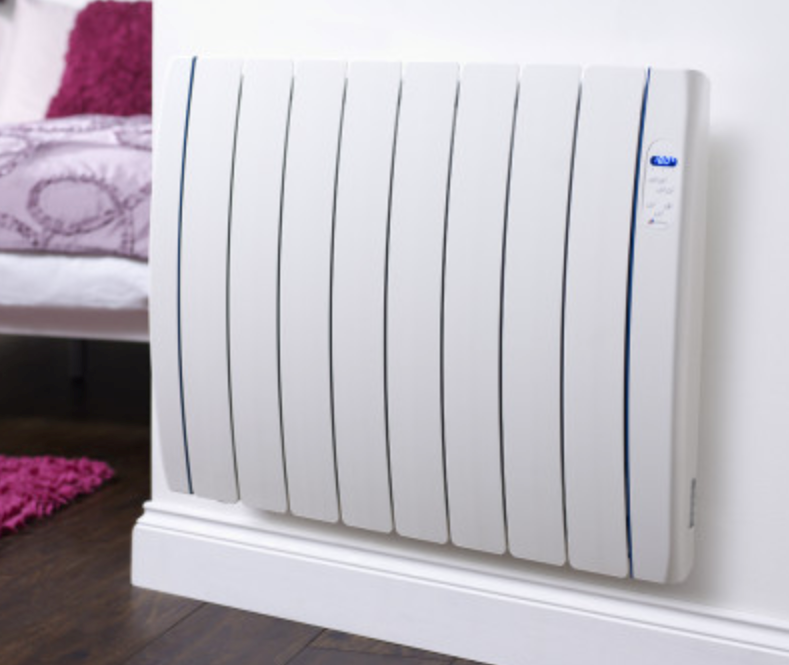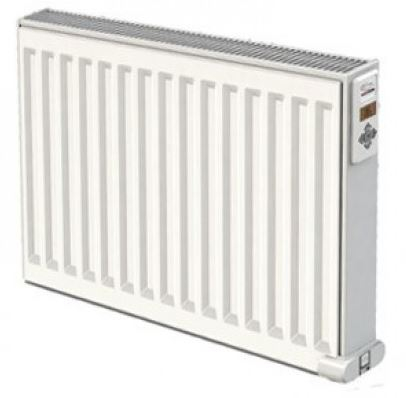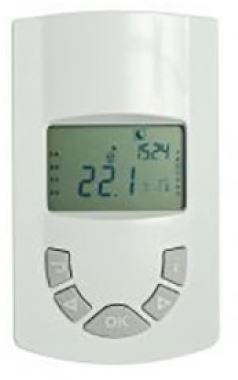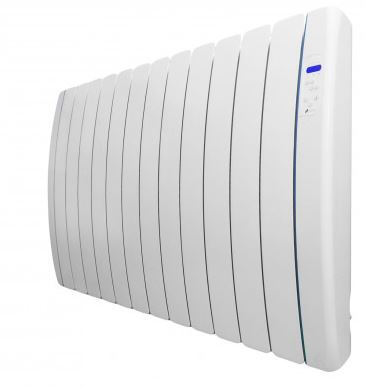
Before we start, why choose oil filled at all?
There are various types of electric radiator on the market, each with their own subtle variations and traits. Whereas other radiators have hollow bodies, oil filled radiators are pre-filled with a specially designed thermal fluid. In essence, you can think of an oil filled radiator as having a layer of insulation inside it. This “insulation,” or thermal fluid, helps to retain heat and stops the radiator from overworking: the ideal solution for large or frequently used rooms that need a lot of heating.
To see exactly how our oil filled electric radiators would fair in the real world, we spent some time getting to grips with two of our products: the Haverland Designer TT and the Electrorad Digi-Line. For our review, we cover installation, programming, and general day-to-day usage, and each section is scored out of 5 respectively, so you can see at a glance how each radiator performed against the other.
The Electrorad Digi-Line
A handsome, traditional-looking radiator, the Electrorad Digi-Line is indistinguishable from conventional central heating systems: the ideal choice for period homes or for those who appreciate a classic aesthetic.
Installation
The Digi-Line’s steel body and sturdy, fluted frame makes it one of the more robust oil filled radiators in our product range. The Digi-Line comes with its own mounting brackets, and all you need to do is mark the position of the brackets on the wall, drill four holes, and hang the radiator like a TV or picture frame. Compared to a flat-pack assembly, installing the Digi-Line is child’s play. The only bugbear we can find is that the Digi-Line doesn’t come with a plug. So, a small amount of screwing and wiring is needed to get the radiator up and running.
The lack of a plug and the fact you may have to do a bit of measuring to mount the Digi-Line knocks two points off here. Aside from that, the Digi-Line scores a solid 3/5 for installation.
Programming
We’ve never met anyone who enjoyed programming their heating. It’s a pretty tedious task at the best of times, but we rolled our sleeves up, put on our glasses, and got to work. The base model Digi-Line doesn’t support full 24/7 programming, which means you have to purchase a Central Programmer to create a comprehensive heating schedule. We didn’t have a Central Programmer to hand, so we used the Digi-Line’s integrated controls instead to see how easy it would be to select our desired heating mode and temperature.
Cycling through the Digi-Line’s heater modes is simple. All you have to do is press the left or right arrows on the control panel and “okay” your desired mode. The Digi-Line comes with the standard comfort, economy, and anti-frost modes – each easily adjustable using the + and – keys. A clear icon is shown on the display each time one of the modes is selected, and a heating icon appears when the Digi-Line is in operation.
Without the Central Programmer, you’re limited to basic heater scheduling without full control of your radiator. No one likes having to purchase an additional device to get the most out of their radiators, so the Digi-Line loses a point for that. Aside from this though, the integrated controls are a doddle to use, scoring the Digi-Line a highly credible 4/5 for programming.
General use
In terms of day-to-day operation, the Digi-Line is an effective oil filled radiator. Once in your desired heating mode, the radiator warms up gently using “soft start” – which allows the Digi-Line to reach your desired temperature gradually over a 20-minute period. Oil filled radiators take a little longer to get going than other types of electric radiator, but this isn’t noticeably longer with the soft start setting in operation.
The Digi-Line also comes with open window detection – a feature that stops the radiator from wastefully heating if it detects a dramatic drop in temperature. For your home, this energy-efficient setting would ultimately save you money, as the Digi-Line shuts down rather than trying to combat the overwhelming heat loss.
The Digi-Line is a stalwart choice for an oil filled electric radiator. No fuss, no frills, and a solid overall performance. For that, we thought it deserved a 4/5 for general use. But then we remembered the lack of detailed programming and the implications that would have on real-life general use, and decided to drop the score down to 3/5…
The Haverland Designer TT
Cut from a different cloth to the Digi-Line, the Haverland Designer TT is a contemporary oil filled radiator that’s recently undergone some design changes to meet the new Lot 20 guidelines.
Installation
A tad lighter than the Digi-Line, the Designer TT is even easier to install. Unlike Electrorad, Haverland include a handy template to mark the drill holes on the wall, which means you can install the mounting brackets in seconds. The radiator attaches at the bottom first, with a little lift-and-jiggle needed to slot the top in place. Unlike the Digi-Line, you won’t need a tape measure and the TT plugs straight into the wall without the need for any additional wiring.
Lightweight, simple, and comfortably a one-man job, we had no choice but to score the TT a 5/5 for installation.
Programming
The TT supports full 24/7 digital programming without the need for an additional controller. Using the panel on the side of the radiator, we set to work exploring the TT’s programming modes.
The TT’s menu is relatively straightforward but does require you to select the language, time, date, and the temperature for each individual setting, in bulk before you begin. It may seem a bit much, but at least you won’t need to do this again and your temperature settings will be saved, ready and waiting for future use. Holding the PROG button will take you to the programming screen and from there it’s a simple case of using the up and down arrows to enter the time and date, followed by the OK button. Pressing OK immediately takes you to the next step, which threw us off at first until we figured out that pressing PROG takes you back a step.
The TT comes with 4 pre-programmed heater schedules, accessible by holding the PROG button and scrolling though the pre-sets with the arrow keys, confirming your selection with the PROG button once again. To create a custom schedule, you have to hold the PROG button and select PLCF, which immediately brings up the 24-hour clock for Monday. From here, it’s a case of cycling through the hours of the day and assigning comfort, economy, or anti-frost modes using the up and down arrows.

Despite the amount of button pressing, the TT’s programming is nothing short of thorough and once you spend time setting it up, you won’t have to touch it again. For programming, the TT scores 4/5.
General use
Because of the new Lot 20 regulations, the Designer TT is packed with energy-saving features, all of which have the potential to slim down your energy bills. The TT comes with open window detection just like the Digi-Line, as well as an integrated energy monitor and adaptive start. For day-to-day use, the energy monitor is a useful addition, showing you the amount of energy used in a 24-hour period in KWh – perfect for the cost-conscious or curious individual.
Throughout our time with the TT, we had no issues. The radiator kept to its heating schedule and we didn’t need to do a thing to alter it. While we didn’t use open window detection, or notice the adaptive start, they’re welcome additions for a 21st century heating system. All of which prompts a score of 5/5.
So, where does that leave us? If you need simple, no frills heating and a traditional aesthetic, we’d recommend the Electrorad Digi-Line, which scored an overall score of 10/15. If you need that bit more from your heating system, we’d recommend the Haverland Designer TT, which scored an impressive 14/15. You’ll be happy to know, despite the increased number of additional features, the Designer TT is less expensive than the Digi-Line. A 1500w Digi-Line will set you back around £468, whereas a 1500w TT will cost £361. If that doesn’t swing the vote for the TT, we don’t know what else will…








